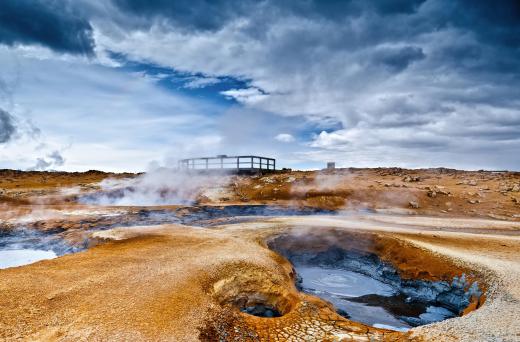What is the Mid-Atlantic Ridge?
 Michael Anissimov
Michael Anissimov
The Mid-Atlantic Ridge is a huge underwater mountain range that runs from just 207 miles (333 km) south of the North Pole to Bouvet Island, located in the Atlantic ocean at a longitude just below South Africa. At about 6,200 miles (10,000 km) long, this range connects to a series of oceanic ridges that encircle the entire planet, with a total length of about 25,000 miles (40,000 km). The mountains are caused by seafloor spreading, the volcanic activity that happens in the central areas of oceanic crust to replenish crust lost through subduction (sliding) under contintental plates. As the subduction only occurs at a rate of only about 1 inch (2.5 cm) a year, only modest volcanic activity is necessary to replenish the lost crust, though over geological time it can create great mountain ranges.
Although the existence of the Mid-Atlantic Ridge was first inferred by Matthew Fontaine Maury in 1850, it was not discovered until 1872, when an expedition of the HMS Challenger discovered the ridge while scouting for a transatlantic telegraph cable. In 1925, a confirmation of the ridge, as well as additional details, were uncovered by sonar. It was found to be 300 to 600 miles (482.8 to 965.6 km) wide, consisting of a parallel series of ridges increasing in height. The mountains are about 2 miles (3.2 km) above the sea floor, which has an average depth of 3 miles (4.8 km). The ridge serves to divide the Atlantic sea floor into two distinct basins.

Some peaks of the Mid-Atlantic Ridge are so tall that they rise above the waterline to form islands. These include Jan Mayen in the Arctic Ocean, Iceland, the Azores, Bermuda (which initially formed on the ridge but is now far west), the Saint Peter and Saint Paul Islets, Ascension Island, Tristan da Cunha (which has the highest point on the ridge, Queen Mary's Peak, 1.24 miles (2 km) above sea level), Gough Island, and Bouvet Island. Many of these islands are inhabited. The range is not a continuous line, but rather consists of many sections misaligned with the others, due to millions of years of intense geological activity.
AS FEATURED ON:
AS FEATURED ON:













Discussion Comments
how does sea-floor spreading cause earthquakes?
well this website is definitely better than some others. it helped me a lot for geography!
I don't understand the mid Atlantic ridge and the explanation to it, so can someone please explain it to me properly in easy words for me to understand as I'm only 11 years old and I'm doing it for homework?
@ Chocada- PelesTears' explanation also describes why the mountains formed of igneous rock in the pacific are so much higher than the mountains on the islands created by the Southern mid-Atlantic Ridge. The hot spot is much more active than the ridge, and the magma plume is fed by the hot spot for a longer period than the plate boundaries in the Atlantic remain in the rift zone.
The Hawaiian volcano Mauna Loa is actually the tallest mountain on earth. It's magma plume sat over the hot spot in the pacific for so long that a mountain that protrudes over 30,000 feet from the sea floor was able to form. This mountain is taller than Mt Everest when measured from the sea floor.
@ Chicada- The two types of geologic features you described share some similarities, but they are in fact two different types of geologic processes.
The Hawaiian Islands and the rest of the islands in the archipelago were formed over millions of years by a volcanic hot spot. A volcanic hot spot is simply a mantle plume that reaches the earth's surface through a thin spot in the lithosphere. The hot spot is stationary, but the tectonic plate, in this case the Pacific plate, slides over the top of it. Think of a candle being a mantle plume and a piece of paper being a continental plate, If you slowly move a taught piece of paper a couple inches over the flame, you will end up with charred areas that would represent a volcanic island chain.
If you actually look at the islands, atolls and seamounts that make up the Hawaiian Archipelago you will see an area where the chain of islands changes direction. This actually marks the point when the movement of the pacific plate changed direction, and by determining the age of the island geologists are able to determine when the shift occurred.
Why aren't the Hawaiian islands, midway, and all of the other islands a chain considered part of a mid-ocean ridge? I was told that the islands are all part of a chain that stretches 5000 miles, but I was also told that there is no ocean ridge in the Pacific Ocean. I don't understand what the difference is between these islands and the ones created by the mid-Atlantic ridge. All of these islands are situated in the middle of an ocean, they were all formed from volcanic activity, and they all follow some sort of recognizable line and pattern. Can anyone explain this to me?
some peaks of the mid-atantic ridge are so tall.
Post your comments